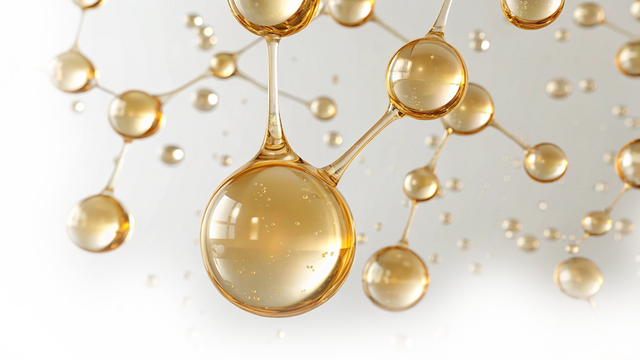
Panel discussion on...
Peptides
Emerging Trends in Peptide Use: Innovations and Applications
What are some of the most exciting innovations in peptide technology that you've seen recently?
How are multifunctional peptides changing the landscape of personal care products?
Multifunctional ingredients are the future of skincare. People want both less and better ingredients because they’ve lived through the science experiments taking place on their faces, with adverse results. It’s also better business for brands as long as those fewer, more multi-function ingredients don’t have a completely out of bounds cost in use given their dose ranges. And, as more multifunction peptides become customer facing (pun not intended… maybe), the more the bar is set in that regard. What’s truly exciting about peptide discovery and design is that we don’t have to stop at multifunctional – they can become multi-multi-multi functional. So, in the discovery space it’s like, let’s not settle for discovering a new land. Let’s discover a new galaxy.
How can peptides differentiate themselves in the competitive, saturated anti-ageing market and what unique benefits do they offer that can appeal to modern skincare consumers?
Peptides enjoy a reputation as a very science-backed category of ingredient, so they already have a bit of a unique standing in the market. What becomes really interesting and market leading is when peptides are also natural and naturally derived. Then, you have a very powerful marriage of scientific standing and a natural claim that is more and more motivating to consumers. Of course, you need to validate the science of your particular peptide, and it has to be highly efficacious in use – a veneer of science will only get you so far – but if combined with that validation, a natural peptide ingredient is very much best of both worlds.
Do you foresee peptides expanding beyond ageing care with the skinification trend?
Peptides have the ability to recreate the supply chains of just about every industry in the world – particularly those in which barrier enhancing technologies are required to increase performance and sustainability. Beyond skinification of say, hair – which peptides have already expanded into – there are industries that peptides can go that leave skinification behind. Peptides have already created the foundation of sustainable chemical systems for a healthier fashion industry, for example. So, it’s easy to go small with the query “where will peptides expand into from skincare”. But the answer is gigantic. Naturally derived peptides are powerful enough to be the material that can enhance just about anything with a surface, and unlock a future that’s far less reliant on petrochemistry.
Mechanisms of Action of Peptide and Market Perception
Which specific skin concerns, like ageing (morphological and dyschromic), are most effectively addressed by peptides, and why?
Skin concerns that are addressed by bioactive regulation, which is a long list of concerns, are very effectively addressed with naturally derived peptides. What that means is efficacies that are achieved when you support the skin’s natural production of highly valuable and powerful foundational proteins – claudin, filaggrin, involucrin, collagen type-1 and others. Your skin knows how to take care of itself, but it is often having a hard time doing so to the extent required, because of age, stress, lack of sleep, diet, exposure to environmental exposure, etc. Naturally derived peptides can help skin mitigate skin concerns naturally via protein upregulation. Specifically, this can be concerns such as a compromised skin barrier, transepidermal water loss, visible hyperpigmentation, symptoms associated with eczema prone skin and more.
There’s a lot of hype around peptides. What are some common myths or misconceptions that you'd like to clarify for both formulators and consumers?
That they need to be synthetic, or that they need to be synthetic to have robust scientific credibility and stability. There are highly efficacious peptides locked within natural resources, that have been there for millions of years, and humans simply did not have the tools to make them available. There’s a perception of sorts that when scientists synthesize something, it must be the most advanced or most powerful version of that material, which is a little bit presumptuous. Nature is really, really, really good at making things. Nature has the patience to R&D materials over millions of years. And when nature makes something, it’s a very good bet that it fits into the idea of a circular economy in which waste and pollution are mitigated, and materials are returned to a regenerative environment. Peptides can be unlocked from natural resources and further designed to meet desired efficacies, and the result is both a truly sustainable material and a highly science-backed ingredient.
Compared to well-known actives like retinoids or vitamins, how do peptides stack up in terms of long-term efficacy and side effects?
Retinoids are a really outdated ingredient. Yes, they work to produce some collagen, but at the expense of youthful, healthy cells. You can’t go out in the sun. You have to build up a tolerance and be very mindful about your routine or you win very bad prizes. I understand why our mothers went through this when they were young, because that was the available technology at the time and it seemed novel, but we really should have moved on by now. Peptides are the answer. If you can support your body’s natural processes, if you are essentially convincing your skin to solve its own problem, then the results are going to be much longer term, and side effects much less of an issue.
Formulation Challenges and Solution
What are some of the biggest challenges when formulating with peptides, particularly in ensuring stability and efficacy? / What are the primary technical hurdles in formulating stable, active peptide products, and how have recent innovations addressed these?
If a peptide is innovated from the beginning to make a formulator’s life easy, then it really should be no issue at all. If the peptide is created to be stable and to formulate as easily as putting 0.25%-2% of water into a formula, then it’s very challenge-free. Additionally, peptides that are water-soluble and designed for optimal skin penetration do not require encapsulation or complex delivery technologies, as they are biocompatible with the skin and can be efficiently absorbed. This makes formulation simpler while ensuring high bioavailability and efficacy without the need for additional stabilizing systems.
Sustainability and Peptide
Sustainability is a growing concern in the cosmetics industry. How are peptide manufacturers addressing this issue?
We can only speak for ourselves, because it’s an issue that often doesn’t come with a high degree of transparency. But we believe in using the United Nations Sustainable Development Goals as a guiding framework, that the tenants of a circular economy are absolutely critical to achieving real sustainability, and that advancing human health is a core component of any definition of sustainability.
What role does biotechnology play in the development of sustainable peptides for personal care products?
Sustainability must be the combination of human health and environmental health. That’s a sustainable future.
Syn bio has been a game-changer in replicating natural compounds, like vitamin C and hyaluronic acid. They were originally derived from nature, have decades (or even centuries) of safe human use, and syn-bio is invaluable in making these molecules more readily available.
But the market is so dynamic and fast moving, governmental agencies can’t regulate the influx of novel biotech ingredients. So, it’s fallen to brands and, unfortunately, the consumer to sort through.
It mirrors the history of petrochemicals in personal care, where potential risks like endocrine disruption were ignored. The concern with biotech ingredients today is similar - without adequate understanding of their safety and sustainability profiles they could pose risks.
That’s health. Environmental sustainability in biotech is also not clear cut. It often relies on massive amounts of energy and sugar and starch for fermentation—industrial monocrop agriculture that requires carbon-intensive and problematic petrochemical fertilizers.
But we can use the tools of biotechnology to unlock peptides from natural, regenerative resources that are known safe, in a way that’s sustainable and supportive of a circular economy – not contributing to waste and pollution, regenerating nature, and ensuring the return to nature. Nature plus biotech science can greatly advance sustainability.
Panelists
References and notes
- Marmiroli N, Maestri E. Plant peptides in defense and signaling. Peptides. 56:30-44, 2014
- Molesini B, Treggiari D, Dalbeni A, Minuz P, Pandolfini T. Plant cystine-knot peptides: pharmacological perspectives. Br J Clin Pharmacol. 83(1):63-70, 2017
- Apone F, Barbulova A, Colucci MG. Plant and Microalgae Derived Peptides Are Advantageously Employed as Bioactive Compounds in Cosmetics. Front Plant Sci. 10:756, 2019
- Zhu Z, Xu Z, Li Y, Fan Y, Zhou Y, Song K, Meng L. Antioxidant Function and Application of Plant-Derived Peptides. Antioxidants (Basel). 13(10):1203, 2024




































